Assessing Anthropogenic Dynamics in Megacities from the Characterization of Land Use/Land Cover Changes: The Bogotá Study Case
Abstract
:1. Introduction
2. Materials and Methods
2.1. Study Area: The Bogotá River Basin
2.2. Datasets
2.2.1. Historic LULC Maps
2.2.2. Complementary Datasets for the LCM Model
2.3. Cartographic Standardization
2.4. Land Change Modeler Application to Bogotá River Basin
2.4.1. LULC Model Performance
2.4.2. Development of Dedicated Sub-Models for LULC Transitions towards Artificial Areas
3. Results and Discussion
3.1. Analyzing the Historical LULC Dynamics Since 1985
3.1.1. Analysis of Forest Degradation and Fragmentation Dynamics
3.1.2. Agriculture Pressure (All Categories 2) on the Forest (Category 3.1)
3.1.3. Transition towards Artificial Areas (from Categories 2 or 3 to Categories 1)
3.2. LULC Dynamics and Futures Scenarios
4. Conclusions
Author Contributions
Funding
Acknowledgments
Conflicts of Interest
References
- UNDESA. World Population Prospects 2019: Highlights; UNDESA: New York, NY, USA, 2019. [Google Scholar]
- UNDESA. World Urbanization Prospect-The 2018 Revisions; UNDESA: New York, NY, USA, 2019. [Google Scholar]
- Aguilar, A.G.; Ward, P.M. Globalization, regional development, and mega-city expansion in Latin America: Analyzing Mexico City’s peri-urban hinterland. Cities 2003, 20, 3–21. [Google Scholar] [CrossRef]
- Kourtit, K.; Nijkamp, P.; Reid, N. The new urban world: Challenges and policy. Appl. Geogr. 2014, 49, 1–3. [Google Scholar] [CrossRef]
- Grimm, N.B.; Faeth, S.H.; Golubiewski, N.E.; Redman, C.L.; Wu, J.; Bai, X.; Briggs, J.M. Global change and the ecology of cities. Science 2008, 319, 756–760. [Google Scholar] [CrossRef] [PubMed] [Green Version]
- European Commission and Joint Research Centre (JRC). Atlas of the Human Planet 2018—A World of Cities; European Commission: Luxembourg, 2018. [Google Scholar]
- Alexandratos, N.; Bruinsma, J. World Agriculture towards 2030/2050: The 2012 Revision; FAO: Rome, Italy, 2012. [Google Scholar]
- Lin, Y.-P.; Chu, H.-J.; Wu, C.-F.; Verburg, P.H. Predictive ability of logistic regression, auto-logistic regression and neural network models in empirical land-use change modeling—A case study. Int. J. Geogr. Inf. Sci. 2011, 25, 65–87. [Google Scholar] [CrossRef] [Green Version]
- Heinrichs, D.; Krellenberg, K.; Hansjürgens, B.; Martínez, F. Risk Habitat Megacity; Springer Science & Business Media: Berlin, Germany, 2012. [Google Scholar]
- Rothwell, A.; Ridoutt, B.; Page, G.; Bellotti, W. Feeding and housing the urban population: Environmental impacts at the peri-urban interface under different land-use scenarios. Land Use Policy 2015, 48, 377–388. [Google Scholar] [CrossRef] [Green Version]
- Haas, J.; Ban, Y. Urban growth and environmental impacts in Jing-Jin-Ji, the Yangtze, River Delta and the Pearl River Delta. Int. J. Appl. Earth Obs. Geoinf. 2014, 30, 42–55. [Google Scholar] [CrossRef]
- Tian, L.; Li, Y.; Yan, Y.; Wang, B. Measuring urban sprawl and exploring the role planning plays: A shanghai case study. Land Use Policy 2017, 67, 426–435. [Google Scholar] [CrossRef]
- Veldkamp, A.; Fresco, L. CLUE: A conceptual model to study the Conversion of Land Use and its Effects. Ecol. Model. 1996, 61, 253–270. [Google Scholar] [CrossRef]
- Kok, K. The role of population in understanding Honduran land use patterns. J. Environ. Manag. 2004, 15, 35–50. [Google Scholar] [CrossRef]
- Brown, L.A. The city in 2050: A kaleidoscopic perspective. Appl. Geogr. 2014, 49, 4–11. [Google Scholar] [CrossRef]
- Rodríguez, J.P.; Camacho, L.A.; Raciny, I.C.; Maksimovic, C.; Mcintyre, N. Bogotá´s urban drainage system: Context, research activities and perspectives. In Proceedings of the 10th National Hydrology Symposium, British Hydrological Society, Exeter, UK, 15–17 September 2008; pp. 378–386. [Google Scholar]
- Corporación Autonoma Regional de Cundinamarca (CAR). Ajuste del Plan de Ordenamiento y Manejo de la Cuenca del río Bogotá; CAR: Bogotá, Colombia, 2016. [Google Scholar]
- Economic Commission for Latin America and the Caribbean (ECLAC). Adaptation to Climate Change in Megacities of Latin America; United Nations: Santiago, Chile, 2014; p. 98. [Google Scholar]
- Islam, M.S.; Ahmed, R. Land Use Change Prediction In Dhaka City Using Gis Aided Markov Chain Modeling. J. Life Earth Sci. 1970, 6, 81–89. [Google Scholar] [CrossRef] [Green Version]
- Sangermano, F.; Toledano, J.; Eastman, R. Land cover change in the Bolivian Amazon and its implications for REDD+ and endemic biodiversity. Landsc. Ecol. 2012, 27, 571–584. [Google Scholar] [CrossRef]
- He, Y.; Ai, B.; Yao, Y.; Zhong, F. Deriving urban dynamic evolution rules from self-adaptive cellular automata with multi-temporal remote sensing images. Int. J. Appl. Earth Obs. Geoinf. 2015, 38, 164–174. [Google Scholar] [CrossRef]
- Corporacion Autonoma Regional de Cundinamarca CAR and Consorcio Huitaca. Ajuste del Plan de Ordenamiento y Manejo de la Cuenca del río Bogotá- Fase Diagnóstico; CAR: Bogotá, DC, Colombia, 2017. [Google Scholar]
- Vásquez, D.L.A.; Balslev, H.; Sklenář, P. Human impact on tropical-alpine plant diversity in the northern Andes. Biodivers. Conserv. 2015, 24, 2673–2683. [Google Scholar] [CrossRef]
- Delgado, J. La Construcción Social del Paisaje de la Sabana de Bogotá 1880–1890; Universidad Nacional de Colombia: Bogotá, Colombia, 2010. [Google Scholar]
- IAvH. Atlas de Páramos; Primera, Ed.; Grey Comercializadora Ltda.: Bogotá, Colombia, 2007; Volume 1. [Google Scholar]
- Sarmiento Pinzón, C.E.; Cadena Vargas, C.E.; Sarmiento Giraldo, M.V.; Zapata Jiménez, J.A. Aportes a la Conservación Estratégica de los Páramos de Colombia: Actualizacién de la Cartografía de los Complejos de Páramo a Escala 1:100.000; Instituto de Investigación de Recursos Biológicos Alexander von Humboldt: Bogotá, Colombia, 2013. [Google Scholar]
- Alonso, D.L.; Pérez, R.; Okio, C.K.Y.A.; Castillo, E. Assessment of mining activity on arsenic contamination in surface water and sediments in southwestern area of Santurbán paramo, Colombia. J. Environ. Manag. 2020, 264, 110478. [Google Scholar] [CrossRef]
- Alcaldía Mayor de Bogotá. Plan Distrital de Desarrollo 2016–2020; Alcaldía Mayor de Bogotá: Bogotá, Colombia, 2016. [Google Scholar]
- Hofstede. The effects of grazing and burning on soil and plant nutrient concentrations in Colombian p, Aramo grasslands. Plant Soil 1995, 173, 111–132. [Google Scholar] [CrossRef] [Green Version]
- Buytaert, W.; Célleri, R.; De Bièvre, B.; Cisneros, F.; Wyseure, G.; Deckers, J.; Hofstede, R. Human impact on the hydrology of the Andean páramos. Earth-Sci. Rev. 2006, 79, 53–72. [Google Scholar] [CrossRef]
- Departamento Administrativo Nacional de Estadistica DANE. Censo Nacional de Población y Vivienda—CNPV 2018; DANE: Bogotá, Colombia, 2018. [Google Scholar]
- Alcaldía Mayor de Bogotá. Análisis Demográfico y Proyecciones Poblacionales de Bogotá; Alcaldía Mayor de Bogotá: Bogotá, Colombia, 2018. [Google Scholar]
- Bocarejo, J.P.; Portilla, I.; Pérez, M.A. Impact of Transmilenio on density, land use, and land value in Bogotá. Res. Transp. Econ. 2013, 40, 78–86. [Google Scholar] [CrossRef]
- Instituto de Hidrología Meteorología y Estudios Ambientales (IDEAM). Leyenda Nacional de Coberturas de la Tierra. Metodología CORINE Land Cover adaptada para Colombia Escala 1:100.000; Editorial Scripto Ltda.: Bogotá, Colombia, 2010. [Google Scholar]
- Mas, J.; Kolb, M.; Paegelow, M.; Teresa, M.; Olmedo, C.; Houet, T. Inductive pattern-based land use/cover change models: A comparison of four software packages. Environ. Model. Softw. 2014, 51, 94–111. [Google Scholar] [CrossRef] [Green Version]
- Pontius, R. Criteria to Confirm Models that Simulate Deforestation and Carbon Disturbance. Land 2018, 7, 105. [Google Scholar] [CrossRef] [Green Version]
- Jat, M.K.; Choudhary, M.; Saxena, A. Application of geo-spatial techniques and cellular automata for modelling urban growth of a heterogeneous urban fringe. Egypt. J. Remote Sens. Space Sci. 2017, 20, 223–241. [Google Scholar] [CrossRef]
- Stellian, R.; Danna-Buitrago, J.P. Competitividad de los productos agropecuarios colombianos en el marco del tratado de libre comercio con los Estados Unidos: Análisis de las ventajas comparativas. Cepal Rev. 2017, 122, 141. [Google Scholar] [CrossRef] [Green Version]
- Saunders, D.A.; Hobbs, R.J.; Margules, C.R.; Biology, C.; Mar, N.; Saunders, D.; Hobbs, R.; Margules, C. Biological Consequences of Ecosystem Fragmentation: A Review. Conserv. Biol. 1991, 5, 18–32. [Google Scholar] [CrossRef]
- Fischer, J.; Lindenmayer, D.B. Landscape modification and habitat fragmentation: A synthesis. Glob. Ecol. Biogeogr. 2007, 16, 265–280. [Google Scholar] [CrossRef]
- Rojas, I.; Becerra, P.; Gálvez, N.; Laker, J.; Bonacic, C.; Hester, A. Relationship between fragmentation, degradation and native and exotic species richness in an Andean temperate forest of Chile. Gayana Botánica 2011, 68, 163–175. [Google Scholar] [CrossRef]
- Mendoza, J.E.S.; Etter, A.R. Multitemporal analysis (1940–1996) of land cover changes in the southwestern Bogotá highplain (Colombia). Landsc. Urban Plan. 2002, 59, 147–158. [Google Scholar] [CrossRef]
- IGAC Instituto Geográfico Agustín Codazzi. ¿En dónde están los mejores suelos para cultivar en el país?|Instituto Geográfico Agustín Codazzi. Available online: https://igac.gov.co/es/noticias/en-donde-estan-los-mejores-suelos-para-cultivar-en-el-pais (accessed on 3 April 2020).
- Departamento Administrativo Nacional de Estadistica DANE. XV Censo Nacional de Población y IV de Vivienda; DANE: Bogotá, Colombia, 1986. [Google Scholar]
- Martínez Herrera, J. El Proceso de Urbanización en los Municipios de la Sabana de Bogotá ∗; Universidad Piloto: Bogotá, Colombia, 2015. [Google Scholar]
- Oviedo, D.; Dávila, J.D. Transport, urban development and the peripheral poor in Colombia - Placing splintering urbanism in the context of transport networks. J. Transp. Geogr. 2016, 51, 180–192. [Google Scholar] [CrossRef] [Green Version]
- Pabón Caicedo, J.D. El Cambio Climático en el territorio de la Corporación Auntónoma Regional de Cundinamarca; CAR: Bogotá, Colombia, 2011. [Google Scholar]
- Lizarazo, P. Cuadernos de Desarrollo Económico 27; RSA: Bogotá, Colombia, 2013. [Google Scholar]
- Secretaria Distrital de Planeación. Plan de Ordenamiento Territorial de Bogotá D.C Documento Resumen; Secretaria Distrital de Planeación: Bogotá, Colombia, 2018. [Google Scholar]
- Corporacion Autonoma Regional de Cundinamarca CAR. Plan de Manejo Ambiental de la Reserva Forestal Regional Productora del Norte de Bogotá, D.C. Thomas van der Hammen; CAR: Bogotá, Colombia, 2014. [Google Scholar]
- Tijacá-Peña, D. Sistema Inteligente y Colaborativo Para la Optimización del Uso de Transporte Publico SICOUT. Master’s Thesis, Universidad Internacional de la Rioja UNIR, Logroño, Spain, 2017. [Google Scholar]
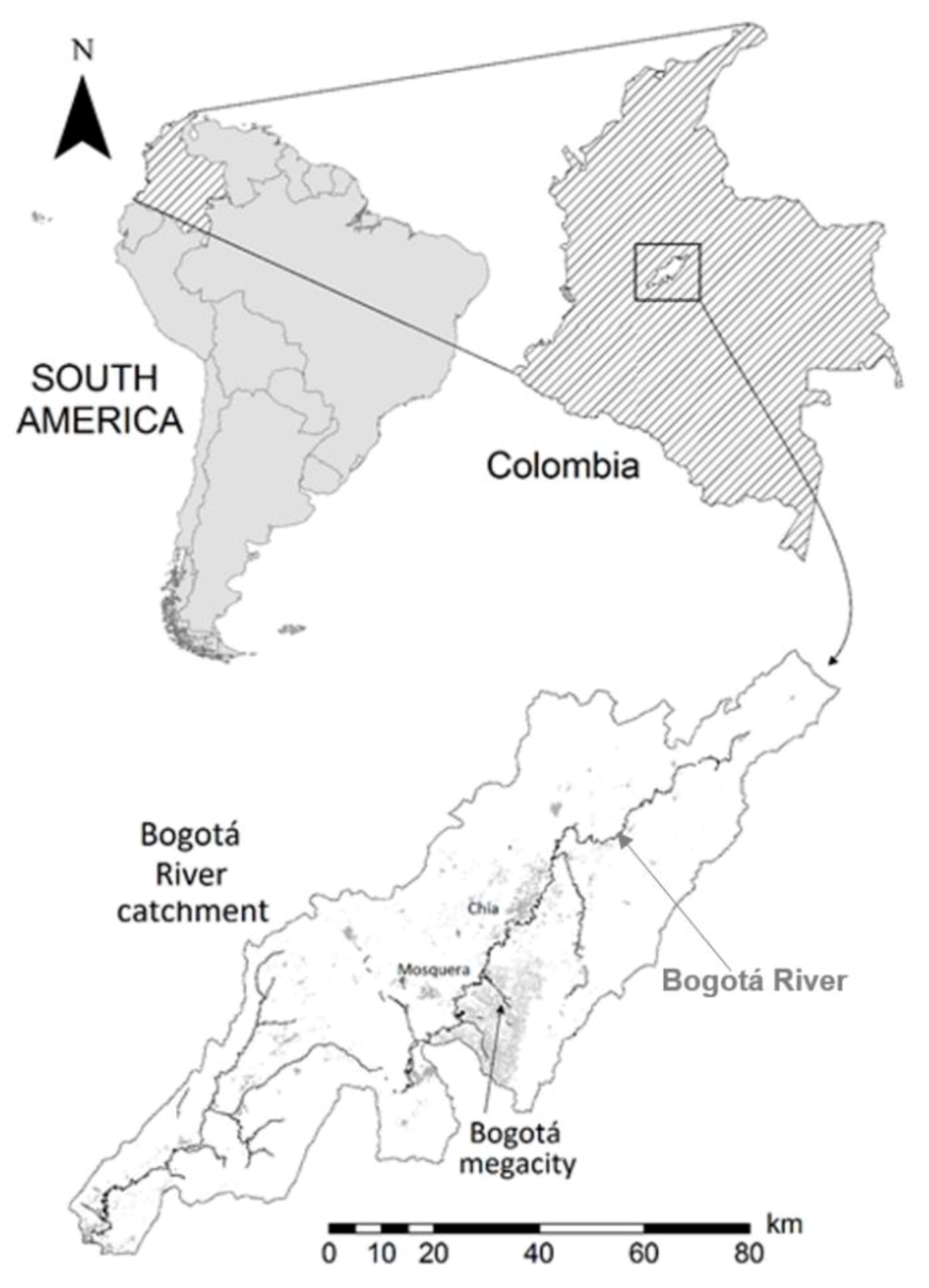
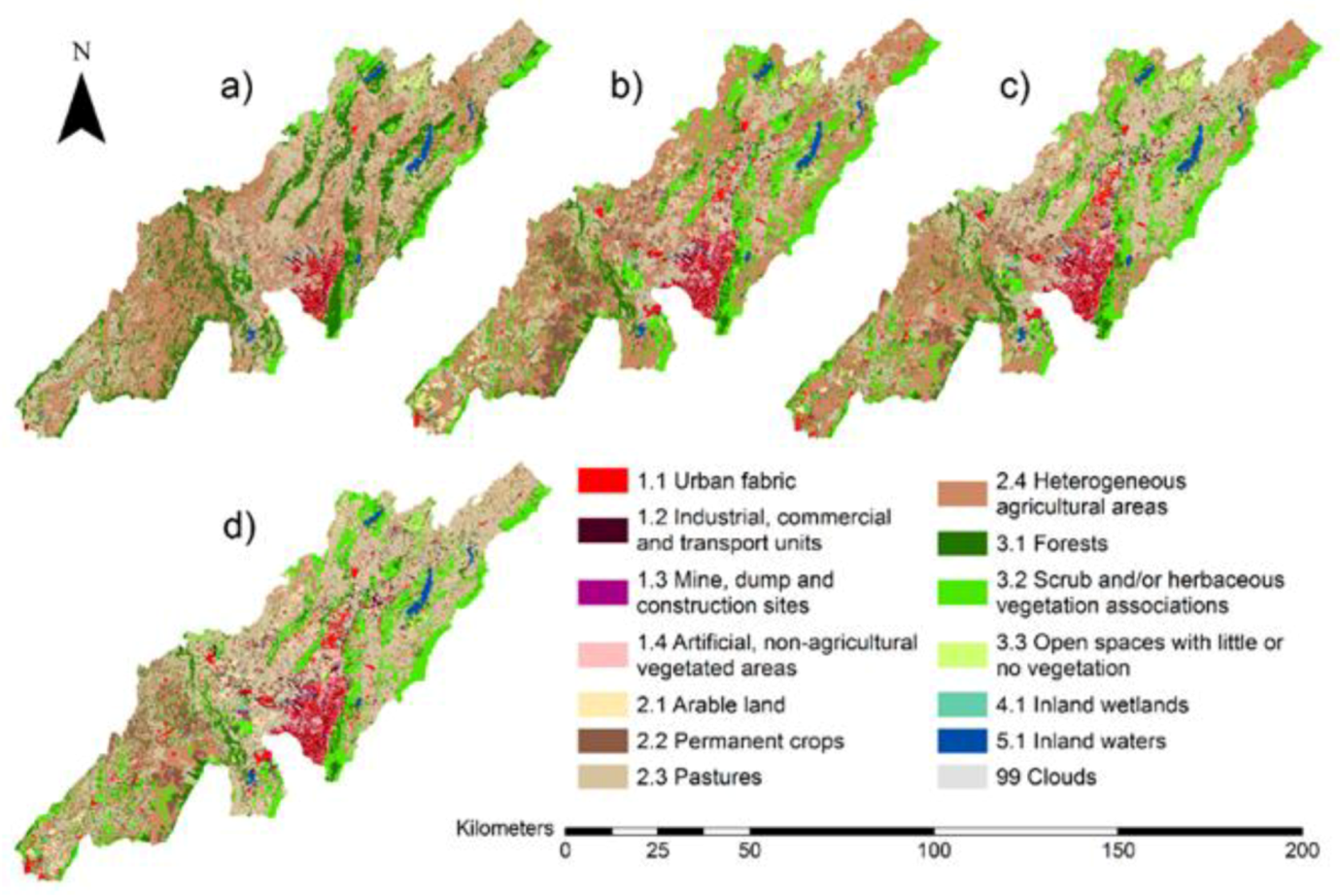


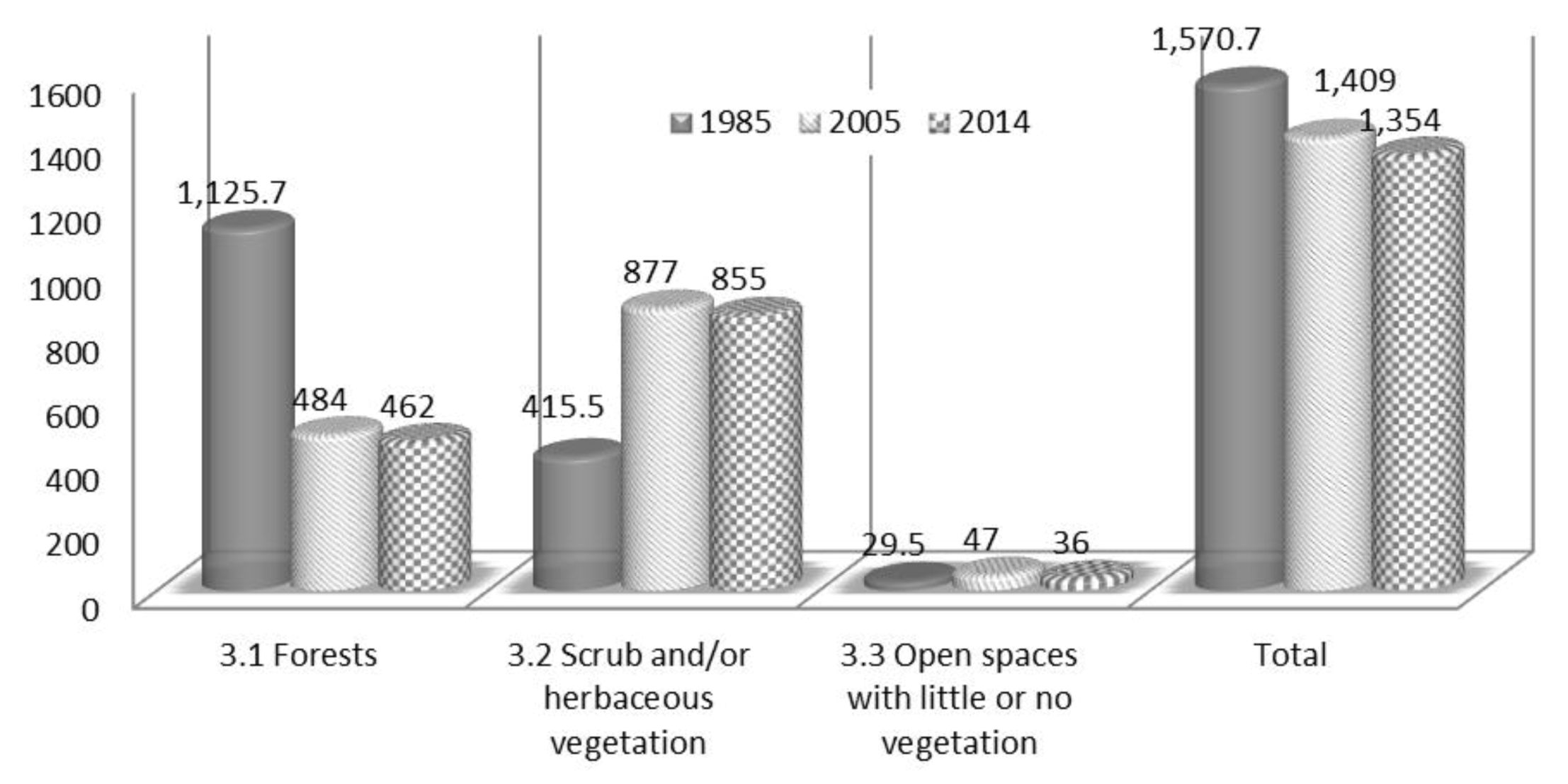
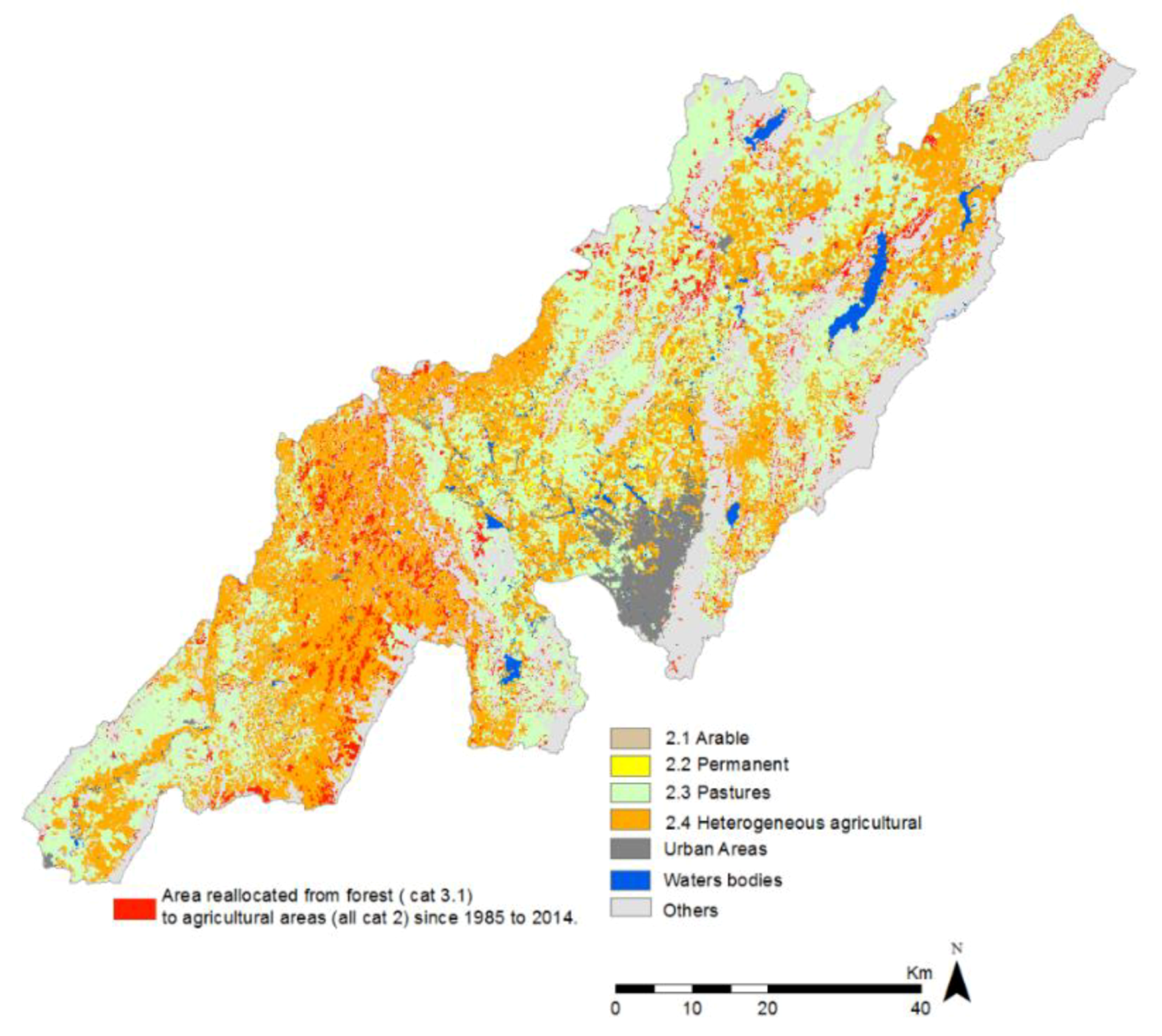
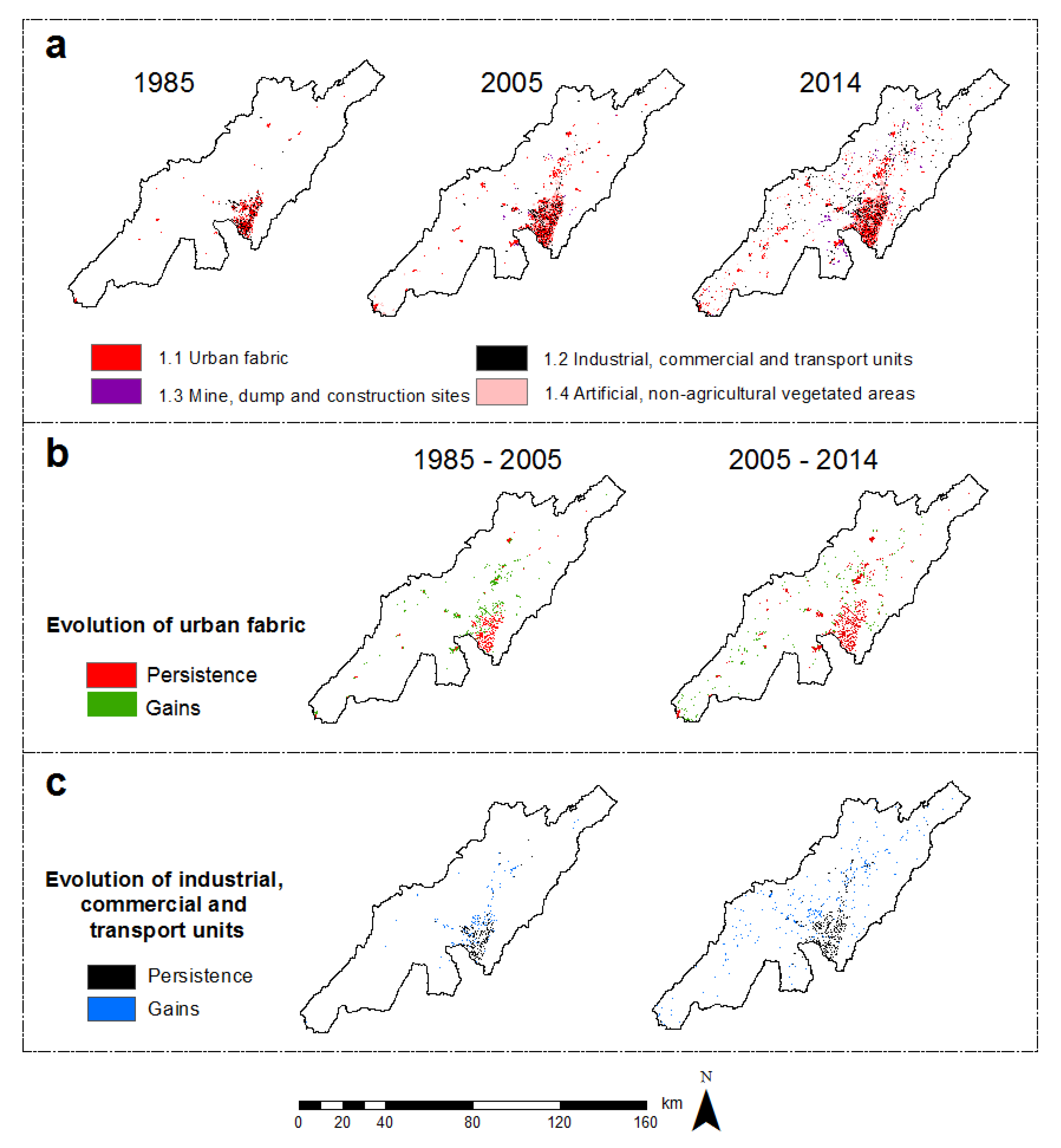
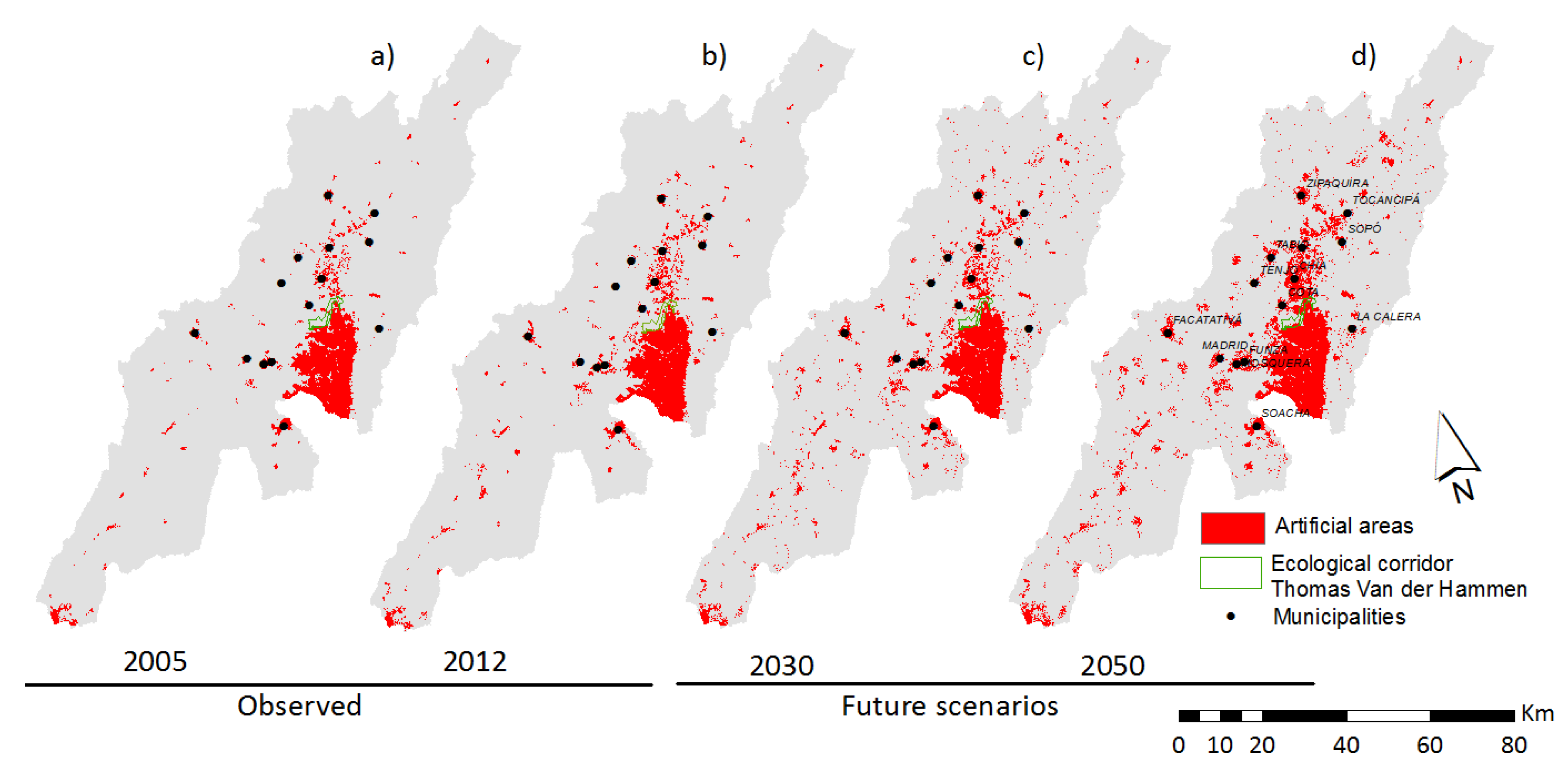

| LULC CORINE Category | % Area in the Basin | Observed (km2) | Forecasted (km2) | Forecasted/Observed (%) |
|---|---|---|---|---|
| 1. Artificial areas | ||||
| 1.1 Urban fabric | 4.0 | 216.4 | 185.2 | 85.6 |
| 1.2 Industrial, commercial, and transport units | 2.9 | 157.0 | 104.6 | 66.6 |
| 1.3 Mine, dump, and construction sites | 0.6 | 31.4 | 17.7 | 56.5 |
| 1.4 Artificial, non-agricultural vegetated areas | 3.0 | 162.7 | 118.7 | 73.0 |
| Subtotal | 10.7 | 567.5 | 426.2 | 72.5 |
| 2. Agricultural areas | ||||
| 2.1 Arable land | 4.3 | 237.6 | 48.8 | 20.5 |
| 2.2 Permanent crops | 5.1 | 277.2 | 98.3 | 35.5 |
| 2.3 Pastures | 44.8 | 2449.3 | 2229.1 | 91.0 |
| 2.4 Heterogeneous agricultural areas | 8.9 | 485.9 | 1181.5 | 243.2 |
| Subtotal | 63.1 | 3450.0 | 3557.6 | 103.1 |
| 3. Forest and semi-natural areas | ||||
| 3.1 Forests | 8.5 | 462.4 | 517.8 | 112.0 |
| 3.2 Scrub and/or herbaceous vegetation associations | 15.6 | 855.2 | 832.7 | 97.4 |
| 3.3 Open spaces with little or no vegetation | 0.7 | 35.9 | 36.7 | 102.2 |
| Subtotal | 24.7 | 1353.5 | 1387.1 | 102.5 |
| 4.1 Inland wetlands | 0.4 | 22.4 | 22.4 | 100.0 |
| 5.1 Inland waters | 1.4 | 77.9 | 77.9 | 100.0 |
| Total | 5471.3 | |||
| Submodel | ||
|---|---|---|
| Parameters and Performance Functions | Green-Urb | Agri-Urb |
| Input layer neurons | 1 | 4 |
| Hidden layer neurons | 7 | 6 |
| Output layer neurons | 2 | 8 |
| Requested samples per class | 500 | 190 |
| Final learning rate | 0.0005 | 0.0010 |
| Momentum factor | 0.5 | 0.5 |
| Sigmoid constant | 1 | 1 |
| Stopping criteria: iterations | 10000 | 10000 |
| Training RMS | 0.4126 | 0.2487 |
| Testing RMS | 0.4045 | 0.2509 |
| Accuracy rate | 93.21% | 56.76% |
| Skill measure | 0.8643 | 0.5058 |
| Final LULC 2014 | Category Total (1985) | ||||||||||||
|---|---|---|---|---|---|---|---|---|---|---|---|---|---|
| 1.1 | 1.2 | 1.3 | 1.4 | 2.1 | 2.2 | 2.3 | 2.4 | 3.1 | 3.2 | 3.3 | |||
| LULC 1985 | 1.1 | 71.43 | - | - | - | - | - | - | - | - | - | - | 71.43 |
| 1.2 | - | 46.03 | - | - | - | - | - | - | - | - | - | 46.03 | |
| 1.3 | - | - | 0.30 | - | - | - | - | - | - | - | - | 0.3 | |
| 1.4 | - | - | - | 33.41 | - | - | - | - | - | - | - | 33.41 | |
| 2.1 | - | - | - | - | 0.27 | 0.13 | 0.24 | 0.06 | - | 0.09 | 0.01 | 0.8 | |
| 2.2 | 0.6 | 0.37 | 0.04 | 0.42 | 0.61 | 8.69 | 3.98 | 0.14 | - | 0.04 | - | 14.89 | |
| 2.3 | 81.90 | 54.88 | 16.47 | 55.03 | 130.16 | 67.47 | 1173.08 | 169.01 | 21.91 | 50.65 | 17.34 | 1837.9 | |
| 2.4 | 52.31 | 44.61 | 4 | 61.1 | 93.27 | 159.88 | 1059.78 | 254.39 | 14.01 | 50.79 | 1.33 | 1795.47 | |
| 3.1 | 7.16 | 7.80 | 5.35 | 10.14 | 8.75 | 40.93 | 177.91 | 55.93 | 404.62 | 402.67 | 4.62 | 1125.72 | |
| 3.2 | 0.71 | 1.48 | 1.1 | 0.9 | 4.53 | 0.04 | 30.71 | 5.88 | 20.80 | 345.87 | 3.33 | 415.51 | |
| 3.3 | 2.33 | 1.80 | 4.12 | 1.66 | 0.04 | 0.01 | 3.62 | 0.48 | 1.09 | 5.11 | 9.23 | 29.49 | |
| Final LULC 2014 | Class total (2005) | ||||||||||||
| LULC 2005 | 1.1 | 151.17 | - | - | - | - | - | - | - | - | - | - | 151.17 |
| 1.2 | - | 82.38 | - | - | - | - | - | - | - | - | - | 82.38 | |
| 1.3 | 0.24 | 0.86 | 7.62 | - | - | - | - | - | - | - | - | 8.72 | |
| 1.4 | 6.53 | 2.05 | - | 107.71 | - | - | - | - | - | - | - | 116.29 | |
| 2.1 | 1.17 | 0.96 | 0.06 | 0.63 | 27.48 | 1.56 | 59.43 | 6.71 | - | 1.63 | 0.03 | 99.66 | |
| 2.2 | 4.53 | 4.66 | 0.04 | 1.17 | 3.40 | 140.36 | 35.85 | 90.87 | - | 16.07 | 0.05 | 297 | |
| 2.3 | 21.93 | 26.32 | 9.95 | 30.44 | 50.25 | 30.53 | 982.74 | 63.64 | 0.03 | 18.30 | 3.41 | 1237.54 | |
| 2.4 | 26.61 | 35.25 | 5.78 | 18.06 | 152.52 | 96.37 | 1280.09 | 313.48 | - | 38.18 | 3.05 | 1969.39 | |
| 3.1 | 0.58 | 1.09 | 0.27 | 0.83 | 0.91 | 1.53 | 22.13 | 1.61 | 418.72 | 35.87 | 0.33 | 483.87 | |
| 3.2 | 2.26 | 2.93 | 3.10 | 3.09 | 2.91 | 6.78 | 63.41 | 9.28 | 43.01 | 734.19 | 6.52 | 877.48 | |
| 3.3 | 1.42 | 0.47 | 4.56 | 0.73 | 0.16 | 0.02 | 5.67 | 0.30 | 0.67 | 10.98 | 22.47 | 47.45 | |
| Class total (2014) | 216.44 | 156.97 | 31.38 | 162.66 | 237.63 | 277.15 | 2449.32 | 485.89 | 462.43 | 855.22 | 35.86 | ||
| where: 1.1 Urban fabric 1.2 Industrial, commercial and transport units 1.3 Mine, dump and construction sites 1.4 Artificial, non-agricultural vegetated areas | 2.1 Arable land 2.2 Permanent crops 2.3 Pastures 2.4 Heterogeneous agricultural areas | 3.1 Forests 3.2 Scrub and/or herbaceous vegetation associations 3.3 Open spaces with little or no vegetation | |||||||||||
| LULC CORINE Category | Area in km² | % in the Basin | Gain or Loss between 2050 and 2012 | |||||
|---|---|---|---|---|---|---|---|---|
| 2012 | 2030 | 2050 | 2012 | 2030 | 2050 | km2 | % | |
| 1. Urban areas | ||||||||
| 1.1 Urban fabric | 178.1 | 248.0 | 328.0 | 3.3 | 4.5 | 6.0 | 149.9 | 84.2 |
| 1.2 Industrial, commercial and transport units | 100.6 | 140.7 | 191.5 | 1.8 | 2.6 | 3.5 | 90.9 | 90.4 |
| 1.3 Mine, dump and construction sites | 17.7 | 17.7 | 17.7 | 0.3 | 0.3 | 0.3 | 0.0 | 0.0 |
| 1.4 Artificial, non-agricultural vegetated areas | 120.7 | 104.3 | 89.5 | 2.2 | 1.9 | 1.6 | −31.2 | −25.8 |
| Subtotal | 417.1 | 510.7 | 626.7 | 7.6 | 9.3 | 11.5 | 209.6 | 50.3 |
| 2. Agricultural areas | ||||||||
| 2.1 Arable land | 48.8 | 48.8 | 48.8 | 0.9 | 0.9 | 0.9 | 0.0 | 0.0 |
| 2.2 Permanent crops | 147.7 | 83.2 | 105.3 | 2.7 | 1.5 | 1.9 | −42.4 | −28.7 |
| 2.3 Pastures | 1867.8 | 2779.6 | 2802.0 | 34.1 | 50.8 | 51.2 | 934.2 | 50.0 |
| 2.4 Heterogeneous agricultural areas | 1487.5 | 657.7 | 589.0 | 27.2 | 12.0 | 10.8 | −898.5 | −60.4 |
| Subtotal | 3551.7 | 3569.3 | 3545.0 | 64.9 | 65.2 | 64.8 | −6.8 | −0.2 |
| 3. Natural areas | ||||||||
| 3.1 Forests | 508.6 | 574.6 | 615.3 | 9.3 | 10.5 | 11.2 | 106.7 | 21 |
| 3.2 Scrub and/or herbaceous vegetation associations | 856.7 | 679.7 | 547.3 | 15.7 | 12.4 | 10.0 | −309.4 | −36.1 |
| 3.3 Open spaces with little or no vegetation | 36.7 | 36.7 | 36.7 | 0.7 | 0.7 | 0.7 | 0.0 | 0.0 |
| Subtotal Open spaces | 1402 | 1290.9 | 1199 | 25.6 | 23.6 | 21.9 | −202.8 | −14.5 |
| 4 Inland wetlands | 22.4 | 22.4 | 22.4 | 0.4 | 0.4 | 0.4 | 0.0 | 0.0 |
| 5 Inland waters | 77.9 | 77.9 | 77.9 | 1.4 | 1.4 | 1.4 | 0.0 | 0.0 |
| The basin’s total area | 5471.2 | |||||||
© 2020 by the authors. Licensee MDPI, Basel, Switzerland. This article is an open access article distributed under the terms and conditions of the Creative Commons Attribution (CC BY) license (http://creativecommons.org/licenses/by/4.0/).
Share and Cite
Romero, C.P.; García-Arias, A.; Dondeynaz, C.; Francés, F. Assessing Anthropogenic Dynamics in Megacities from the Characterization of Land Use/Land Cover Changes: The Bogotá Study Case. Sustainability 2020, 12, 3884. https://doi.org/10.3390/su12093884
Romero CP, García-Arias A, Dondeynaz C, Francés F. Assessing Anthropogenic Dynamics in Megacities from the Characterization of Land Use/Land Cover Changes: The Bogotá Study Case. Sustainability. 2020; 12(9):3884. https://doi.org/10.3390/su12093884
Chicago/Turabian StyleRomero, Claudia P., Alicia García-Arias, Celine Dondeynaz, and Félix Francés. 2020. "Assessing Anthropogenic Dynamics in Megacities from the Characterization of Land Use/Land Cover Changes: The Bogotá Study Case" Sustainability 12, no. 9: 3884. https://doi.org/10.3390/su12093884





